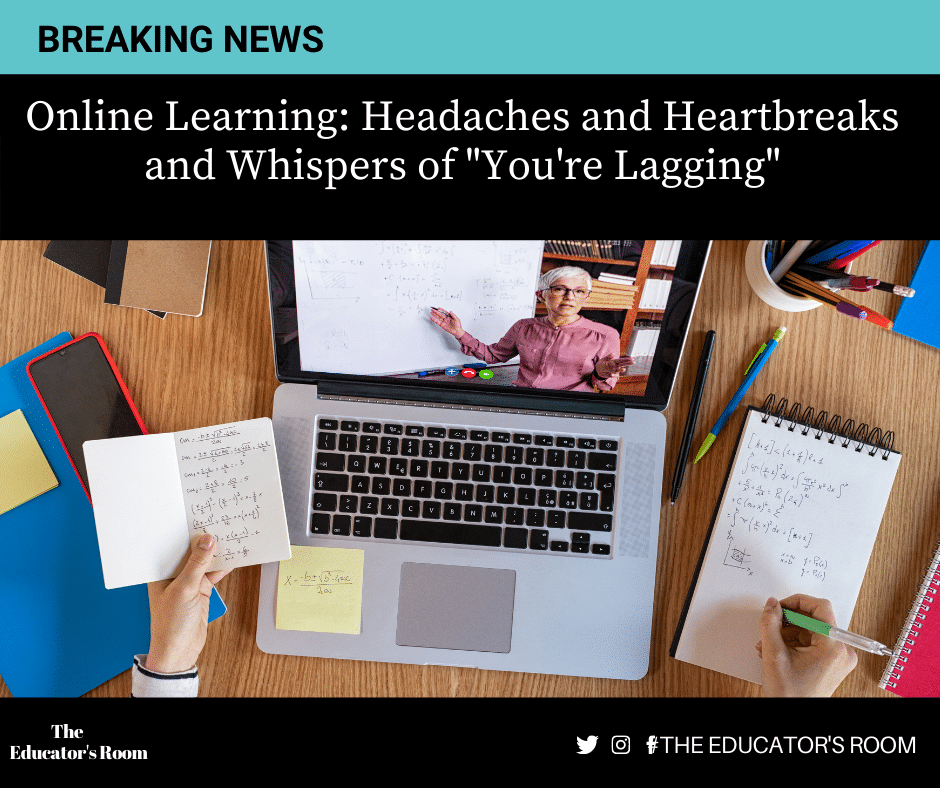You may have seen the meme on social media where it likens virtual learning to a séance: “Sally, can you hear me?”, “Bobby, are you there?”, “Knock if you can hear us”. I shared this meme with my students a few weeks ago after an incredibly frustrating week of teaching to a computer screen with little to no interaction. The kids thought it was funny, I found it to be so true it’s sad. I miss teaching, like most teachers, to real live kids. Teaching virtually has added a whole new level to the term “teacher burnout”.
The Headaches
I am someone who suffers from migraines. If you’ve never had a migraine, you’re truly blessed. If you have, you know the inability to function on even the smallest level. Last month, I had 12 computer-induced migraines. The only way to stop the migraines is to take migraine medication which sends me into a doped-up stupor so naturally I don’t enjoy taking the medication while at school.
Typically, if I can get the lights turned down and look away from the computer screen for a bit, I can lessen the pain, nausea, dizziness, etc. Unfortunately, in the current climate, my job is 100% staring at a computer screen. Not only does it impact my effectiveness as a teacher during the day, but it also impacts my effectiveness as a human when I leave school. The anxiety I feel every day going into school wondering if I will end up incapacitated yet again is slowly whittling away at my mental wellness.
Now You Hear Me, Now You Don’t
The art of the “teacher voice” has been something I’ve worked on for 11 years and counting. My friends or family joke that I should use my teacher voice at certain times or that I am using my teacher voice with them. Using that teacher voice is what commands attention in my classes and keeps my students focused.
When kids are in front of me in their seats, it’s easier to keep that teacher voice to the appropriate volume and intensity, however, with students in class and online, that teacher voice is struggling to find its comfort level. Teaching online with a sub-par microphone on my laptop while it needs to be set up on a stack of toppling books at a specific space away from the board so my kids can see what I’m doing both in class and online has been a challenge. I can’t get close to the computer because the computer is close to the students in the class and I have to stay six feet away from them.
So now, beginning at 7:40 in the morning, I use my stage version teaching voice all day long. By the time 8th period rolls around, I apologize to my students and ask that they read/participate more because I’ve officially lost my voice.
Technical Difficulties
I’d like to take this opportunity to say that I appreciate the technology provided by my school district. There is no way any of this would be possible without the laptops, Chromebooks, document cameras, and projectors offered by my district. I have worked in a school where I had to beg for two desktop computers for my classroom, I couldn’t imagine doing virtual learning in that environment at this point.
That being said, we are doing our best as teachers. So many of us are trying to figure out how to take lessons and curriculum and to turn them into interactive online experiences. Let’s be honest, even adults hate staring at a computer screen all day “learning” via slideshow.
As teachers, we know that and we are trying to create fun lessons for our students who can’t be with us in person. So, we’ve educated ourselves on Nearpod, Peardeck, Jamboard, Google Forms, Edpuzzle, and Kahoot to name a few. If those words all sound foreign to you, many of them sounded foreign to us as well before last March.
Our district also requires us to use Google Classroom to post all assignments, Google Meet to run our online classes, and some sort of recording program like Screencastify or Quicktime to record our live lessons. Our teacher computers can only handle so many moving parts and often, they can’t handle the pressure. I’ve had my computer freeze and tick like a bomb during classes, boot me offline, and completely shut down without being able to be brought back to life.
“You’re Lagging”
Thanks to our new online world, both students and teachers alike have adapted this new phrase of “you’re lagging”. Students at home have internet issues consistently because not only are they online, their brother and sister are online for school as well as mom and dad for work. They have their PlayStation going in the background and Netflix is streaming “Elf” in the other room. The internet is struggling.
On the teacher’s side in the classroom, I am sharing bandwidth with thousands of others in my building. The number of times students at home have shared that they “can’t see the board” or “you’re lagging” is astounding. When this happens, naturally, the show cannot go on. We spend more time trying to fix the technology problems than teaching and valuable learning is lost.
Why Am I Failing?
This section is my-job specific. As a 15:1 Special Education Teacher, I have a caseload of 15 students. That does not count the other 38 students in the specialized reading program I teach. The 15 students are “my kids”. I’ve always treated them like they are my special group of students because we are together every day for three years. We get to know one another and my room is a safe space for them.
Unfortunately, along with that special relationship comes a string of expectations from everyone else. My job as their teacher is to teach them skills that support their IEP goals. The goals are created because those are the skills they need to close the gaps in their learning. With me so far? Seems reasonable, right?
During my 37-minute period, I teach skills that support their IEP goals. During my planning, I write IEP’s, plan lessons, progress monitor their goals, and plan my lessons and grade for my specialized reading program. Lately, I’ve been fielding a lot of emails from other teachers, TAs, parents, and counselors asking why students on my caseload are failing. Parents wonder why their child hasn’t turned in three math assignments in this marking period. Teachers tell me that “my” student hasn’t completed an essay and needs to work on it during my class. Students come to me freaking out about not having their assignments done (that were completed in class with their teachers).
Now, I know we always need more time. But I’m truly trying to figure out how I can help my students pass their classes, do their missed work, and do my actual job all within 37 minutes. I can’t, can I? So, I offer to meet during my planning periods, my lunch, and after school which is the only way to get these poor kids caught up. They’re drowning in work and are struggling so much with the online learning my heart hurts. It’s times like these when we need to realize that our special education students are “our” kids and not just “my” kids.
I Want to Come to School
Words every teacher wants to hear. Our school is currently doing a hybrid model where students come to school physically on Monday/Thursday or Tuesday/Friday. They are virtual the other days of the week. The number of students who want to physically be in school every day is amazing. My heart breaks when they tell me how much they are struggling at home.
I have students who are excelling at home which is wonderful, but the majority of my students are struggling to tread water. They miss the structure and in-person support from their teachers. They miss their friends, sports, and after school activities.
And they are failing. My students are falling apart. They are distracted at home, don’t have the support, and are just giving up. It feels that no matter the amount of support I give them and the amount of time I can be with them, it isn’t enough. I have the best job in the world, and yet, I feel like I’m failing as their teacher.
We want things to be normal again, but I have a bad feeling that this will be a new normal, at least for a while. That means to get our students through it, we need to come together. Parents need to step up and support their kids at home if they aren’t already and they should continue to support if they are doing a killer job. Students need to be active members of their education. And as teachers, we need to work through the headaches, heartbreaks, and technology problems. This won’t last forever (hopefully) but for now, it’s what we have and we need to make it work.






